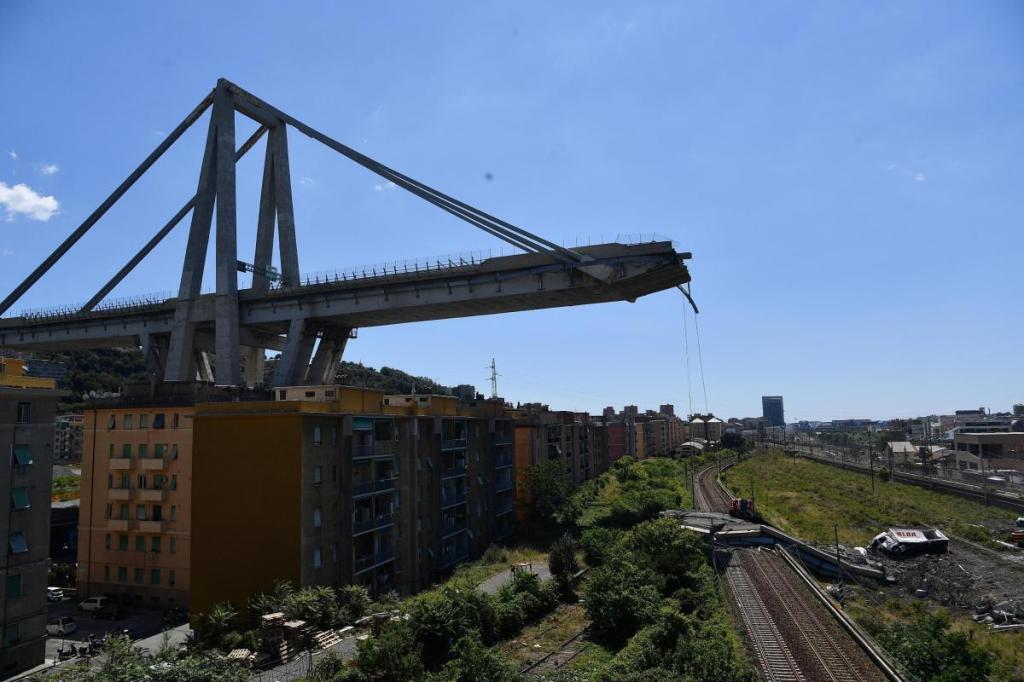GENOA, Italy — As more bodies were pulled Wednesday from a mountain of jagged concrete and twisted steel left by a highway bridge collapse that killed 39, prosecutors focused on possible design flaws and past maintenance of the heavily used span, and politicians squabbled over blame.
Motorists, meanwhile, recounted miraculous escapes and the horror of seeing others plunge over the edge.
As a second night descended on the site where part of the Morandi Bridge plunged some 150 feet, Interior Minister Matteo Salvini declined to say how many people might still be buried in the debris where rescue workers searched for victims.
The collapse occurred about midday Tuesday, the eve of Italy’s biggest summer holiday, when traffic was particularly busy on the 51-year-old span that links two highways – one leading to France, the other to Milan – from this northwestern port city.
Salvini declined to say how many people are still missing, and he added that trying to locate them was particularly difficult, due to the holiday.
“It’s not easy to distinguish between who doesn’t respond because they are on the other side of the world and turned off their phone to relax” on vacation, and “who’s not responding because they are under the rubble,” he said.
Authorities urged the quick removal of tons of debris from a dry river bed so that the rubble doesn’t create a makeshift dam if heavy rains fall in the flood-prone city.
Debris also must be cleared from railroad tracks, a vital link especially now that Genoa is largely cut in half by the loss of such a key artery, Premier Giuseppe Conte said.
Authorities worried about the stability of remaining large sections of the bridge, prompting a wider evacuation order and forcing about 630 people from nearby apartments, some practically in the shadow of the elevated highway.
Building a new bridge could require razing the evacuated buildings, said Transportation and Infrastructure Minister Danilo Toninelli.
After leading an emergency Cabinet meeting in Genoa, Conte said there were 39 confirmed dead and 16 injured, including nine in serious condition. Three children were among those killed, Salvini said.
The dead included four French citizens traveling to a music festival and two Albanians.
Genoa Prosecutor Francesco Cozzi told reporters the investigation into the collapse was focused on human causes, specifically any possible design flaws in the bridge’s construction or any inadequate maintenance.
He said he didn’t know who might be responsible, but added: “It wasn’t an accident.”
Asked if authorities had any warning that the bridge could be dangerous, Cozzi indicated that no serious safety concerns had reached his office before the collapse.
Otherwise, “none of us would have driven over that highway 20 times a month, as we do,” he said.
A $22.7 million project to upgrade the bridge’s safety had already been approved, with public bids to be submitted by September. According to business daily Il Sole, improvement work would have involved two weight-bearing columns that support the bridge – including one that collapsed Tuesday.
The bridge, considered innovative when it opened in 1967 for its use of concrete around its cables, was long due for an upgrade, especially since it was more heavily trafficked than its designers had envisioned.
One expert, Antonio Brencich at the University of Genoa, had previously called the bridge “a failure of engineering.” Other engineers, noting its age, said corrosion and decades of wear-and-tear from weather also could have been factors in the collapse.
Copy the Story LinkSend questions/comments to the editors.



Success. Please wait for the page to reload. If the page does not reload within 5 seconds, please refresh the page.
Enter your email and password to access comments.
Hi, to comment on stories you must . This profile is in addition to your subscription and website login.
Already have a commenting profile? .
Invalid username/password.
Please check your email to confirm and complete your registration.
Only subscribers are eligible to post comments. Please subscribe or login first for digital access. Here’s why.
Use the form below to reset your password. When you've submitted your account email, we will send an email with a reset code.